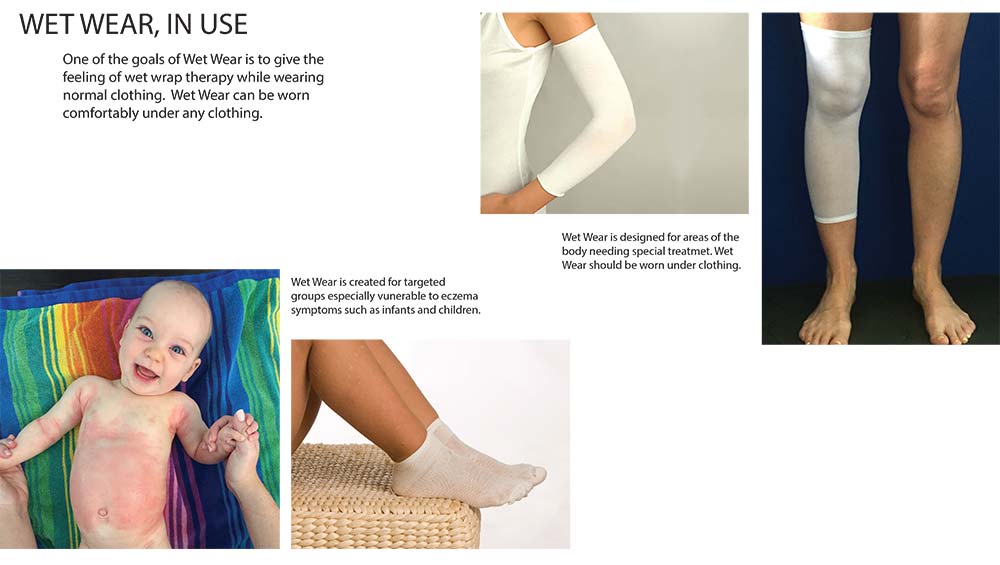
Wet Wear
DESCRIPTION:
Skin conditions such as dermatitis or eczema fall into a group that includes atopic dermatitis, allergic contact dermatitis, and stasis dermatitis. These skin conditions involve inflammation of the skin and are usually characterized by itchiness, red skin, and rash. If the duration of the ailment is short, there may be small blisters, but if the condition is prolonged a thickening of the skin may become evident. The areas covered can vary from small patches to the entire body being affected. The exact cause of dermatitis has not been determined as yet. People affected by the condition often experience combinations of irritations, allergies, and poor blood circulation of the skin. The person’s history and the location of the rash are used to determine the type of dermatitis present. The constant wetting of the skin is often in association with irritant dermatitis while allergic rashes are related to contact with an allergen. All types of dermatitis result in an epidermis reaction resulting in rashes and itching.
Worldwide hundreds of millions of people are suffering from dermatitis. Atopic dermatitis is the most common form and is noted to start in childhood. People in the United States are affected at 10 to 30% of the population in any given year. The condition seems to affect females twice as often as males. The contact variety can affect people exposed to irritants in certain types of employment, household chemicals or irritant plants such as poison ivy.
Treatment of skin conditions such as dermatitis often involves the application of moisturizers and steroid creams in an attempt to get moisture back into the skin. In severe cases, the pain and itching can be relieved by applying wet cloths to the affected areas of the skin. Cooling and getting moisture back into the skin is one of the most soothing treatments for dermatitis and other inflammations of the skin. The feeling that the skin is hot and itching is most distressing for people suffering from these conditions. Clothing can irritate already sensitive skin that is affected by the ailments associated with skin issues. Current therapy is wet-wrap therapy, and it has proved very popular with sufferers of skin conditions. The therapy consists of layering wet cloth between the clothing and the skin. While this therapy seems effective in relieving symptoms, it often results in wet clothing which can be uncomfortable also.
The Wet Wear is an innovative product that can relieve the uncomfortable and damp conditions occurred when applying wet-wrap therapy. The Wet Wear design creates a barrier between the clothing and the wet therapeutic cloth. Wet Wear can hold the moisture while keeping the clothes on the outside dry and comfortable. Wet Wear is designed to be area specific and can be applied to regions of the body that require wet- wrap treatment. The product is targeted to especially susceptible groups of individuals that would include children and infants as well as adults. The Wet Wear product consists of a dual layer material that has a plastic moisture barrier that is applied next to the damp wet-wrap therapy material. The outer material will remain dry and will not absorb any moisture from the wet-wrap. The Wet Wear fabric is elastic so that it will fit shapes and areas of the body snugly and not shift its position. Specific shapes areas such as the hands, feet, and joints including the knees and elbows have purposely fitted coverings for those areas for efficiency and comfort. Different sizes are available to fit everyone suffering from these debilitating skin conditions. The Wet Wear product can bring relief to those people using wet-wrap therapy by keeping their clothing dry and comfortable during their healing process. The Wet Wear product is completely disposable for convenience and sanitary purposes.
SPECIFIC, UNIQUE FUNCTIONS OF INVENTION:
- Prevents clothing from getting wet during therapy
- Keeps therapy close to the skin without movement
- Specialized shapes of Wet Wear for hand, feet, knees, elbows, etc.
- Different sizes available
- Double layer of waterproof material on the therapy side and dry fabric on the outside.
- Elastic fabric allows for good fit and comfort
- Assures that wet therapy makes good contact with skin
- Suitable for infants and children
- Quickly and easily applied and removed
- Completely disposable
PRODUCT COMPONENT CLARIFICATION:
The “Wet Wear” is an innovative health and hygiene product that has been designed to comfortably allow the use of wet wrap therapy throughout the night, while resting or sleeping, without getting the bed linens or furniture wet. When dermatitis or eczema flares up it can be extremely uncomfortable with accompanying severe itch or pain. When emollient and topical medicine is applied, it often does not do enough to alleviate the symptoms. In those cases, it is very helpful to engage in ‘wet wrap’ therapy. The “Wet Wear” product line allows the user to effectively apply the wet wraps and then shield the surroundings from the moisture therein, while maintaining the most effective therapy possible. After use, the protective “Wet Wear” garments can be rinsed (or machine washed) and line dried for the next use.
Currently, wet wrap therapy can be conducted and while it relieves the symptoms for a period of time, when the moisture laden fabric draped over the rash dries out, the dermatitis or eczema can be worsened. Some people wrap the draped and moistened cloths with plastic wrap, (or other moisture barrier) to keep the moistened fabric wet and not dry out. This covering is or can be cumbersome and does not drape well, preventing rest or sleep. It often leaks at the joins and can get medication, emollient residue, or water all over the furniture or bed lines.
The ‘Wet Wear” resolves most of these problems by providing a smooth draping, very comfortable water molecule barrier between the wet wrap moistened gauze or fabric and the bed linens or furniture. These water barrier “Wet Wear” garments are sold pre-made to fit the hand, leg, arm, thorax, neck or face. Each of the garments are sold in 4 standard sizes, i.e., small, medium, large, and extra-large with special sizes made available upon special request.
The sandwiched fabric allows volatilized water vapor to be wicked away and ejected into the ambient atmosphere so the exterior of the garment is dry to the touch, but keeps much larger water molecules retained in the moistened fabric on the skin for the maximum in symptom relief. The sandwiched garments drape smoothly and are very comfortable so they do not interrupt the rest or sleep while delivering the optimum in ‘wet wrap’ therapy.
The garment: The garment is sewn from hypoallergenic, spun fiber polyethylene sandwiched to woven polyester/spandex fabric material. This material prevents the larger water molecules from translating to the outside layer of the fabric while allowing the much smaller water vapor molecules to transit the fabric and be rejected into the surrounding atmosphere. This allows the outer surface of the fabric feel dry to the touch, while retaining the moisture on the treated area. The thermally bonded, sandwiched material is cut to shape from bolts of cloth using computer controlled rolling cutters. After cutting, the edges are turned under and single stitched using nylon thread. The join is closed using an overlap technique and the join is closed using inexpensive fasteners like hook and loop, buttons, hook and eye, plastic zippers, or even plastic slide locks (like sandwich bags), which are sewn in place to finish the garment. The garment is sewn to snugly fit over the moistened gauze of cotton fabric, yet not disturb it and cause it to slide around. The fabric is machine washable, or can just be rinsed and line dried before the next use. If the inexpensive garment becomes irreversibly soiled and the user does not wish to wash it any more, they can recycle it at any polyethylene approved recycler or can simply dispose of it in the trash.
The Wet Wear is designed to be aesthetic and effective in the application. The relative ease of manufacture and the moderately inexpensive components provide good marketability for the manufacturer. The user benefits from improved comfort, improved sleep, and better treatment of eczema, which should provide considerable market interest in the product.
- While eczema is described in this document, any rash, abrasion, or burn that would benefit from ‘wet wrap’ therapy can be treated using the proper emollient and distilled water over hypoallergenic gauze or cotton fabric, which is then covered with the “Wet Wear” garment.
The invention is illustrated in the following drawings of the essential points as explained to us in the documentation.

Drawing 1, Block 1: Wet Wear – Applied To Leg With Eczema
(1) During particularly intense eczema flare ups with severe itch or pain, your health care provider may recommend wet wrap therapy.
(2) Eczema flare up on the leg or elsewhere on the body can be very painful or itch severely.
(3) Wet wrap therapy can work wonders on rehydrating and calming the skin while allowing the topical medications to work more effectively.
(4) However, just draping the skin with moistened gauze or cotton often aggravates the eczema when/if the fabric dries out. Additionally, the wet gauze soaked with water and emollients can soil furniture or bed linens if it contacts them inadvertently.
(5) The “Wet Wear” garment reduces the drying out of the gauze or cotton fabric by providing a water molecule barrier and preventing the moisture from exiting over a whole sleeping period.
(6) The thin and comfortable sandwich of spun fiber polyethylene mated with polyester/spandex drapes well and moves well with the underlying fabric without binding. The garment also fits snugly but does not compress or slide the wound dressing underneath.
(7) The product can be joined with hook and loop fasteners, zippers, or almost any other inexpensive fastener that allows the outer protective fabric layer to be draped over the moistened gauze and then secured so the moisture does not bleed past the join.
Drawing 1, Block 2: Wet Wear – Moisture Trapping Fabric Detail
(8) The sun fiber polyethylene allows the water vapor to move through but blocks water molecules from moving through the fabric, while retaining its softness against the skin.
(9) The woven polyester backs up the polyethylene fabric and allows the water vapor to be ejected into the atmosphere so the wearer is always dry to the touch.
(10) The gauze or cotton fabric is moistened so it can keep the underlying skin moist over long periods of time.
(11) The topical medication and emollient is gently applied to the affected skin.
(12) Back side of the affected skin.
(13) The affected skin is treated with the medication and then is draped with the moistened fabric.
Drawing 1, Block 3: Wet Wear – Treatment Process
(14) Apply emollient and topical medicine to the location of the eczema flare up.
(15) Moisten the fabric dressing (gauze or cotton) until it is slightly damp and place on the skin over the eczema flare.
(16) Gently place another layer of moistened fabric over the flare.
(17) Cover with “Wet Wear” sandwiched fabric garment, which will allow vapor to escape but keep the flare up hydrated. The fabric covering is a “Wet Wear” garment like a glove, arm sleeve, leg sleeve, etc.
(18) Remove “Wet Wear” in the morning, rinse (or machine wash) and air dry for the next use.
(19) As an option, the “Wet Wear” garment can be recycled at any spun polyethylene fabric recycler.
Although a single embodiment of the invention has been illustrated in the accompanying drawings and described in the above detailed description, it will be understood that the invention is not limited to the embodiment developed herein, but is capable of numerous rearrangements, modifications, substitutions of parts and elements without departing from the spirit and scope of the invention.
This document has been prepared for the manufacturer’s elucidation. The manufacturer’s decision makers should consider this product for licensing (providing intellectual property protection for their sales of the product in return for a royalty payment for a period of years) or an outright purchase of the patent for a negotiated fee. The inventor and her team are standing by to consider offers for licensing or outright purchase of the patent.


